Why Growing Medicinal Herbs in Small Spaces is Easier Than You Think?
You don’t need a huge backyard to enjoy the benefits of medicinal herbs. In fact, some of the most powerful healing plants grow beautifully in small pots, containers, or even on a sunny windowsill.
Think about it for a moment—every time you make a cup of chamomile tea for stress, apply aloe vera gel on a burn, or sip peppermint tea for digestion, you’re already experiencing the healing power of plants. Now imagine having these herbs growing just a few steps away from your kitchen.
That’s the beauty of container gardening: it’s simple, affordable, and space-friendly. Even if you live in an apartment, dorm, or urban home with no backyard, you can still create your own mini healing garden.
In this guide, we’ll explore the best medicinal herbs you can grow in pots, their healing benefits, and practical tips for keeping them thriving year-round. By the end, you’ll see how a few pots of green can transform into a mini backyard pharmacy—right on your balcony, patio, or window ledge. 🌱
Benefits of Growing Medicinal Herbs in Pots
Growing medicinal herbs in pots isn’t just about saving space—it actually comes with unique advantages that make them easier to care for compared to traditional garden beds. Whether you’re a beginner or someone who wants fresh herbs at arm’s reach, here are the biggest benefits:
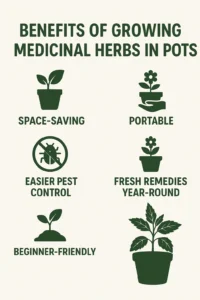
🌱 1. Space-Saving
You don’t need acres of land. A few pots on your balcony, kitchen windowsill, or patio can hold a powerful collection of healing herbs. Even if you live in an apartment, you can grow a mini medicinal garden.
🌱 2. Portability
One of the best things about pots is that they’re portable. If the weather changes, you can move your herbs indoors during the winter or place them in a sunnier spot when needed. This flexibility helps your plants thrive all year round.
3. Easier Pest Control
When herbs are in pots, they’re easier to protect from pests and diseases. You can isolate a sick plant, treat it separately, and keep the rest of your garden safe.
4. Fresh Remedies Anytime
With a small indoor herb setup, you can pick leaves for tea, salves, or tinctures at any time—no need to run to the store. Having your own healing herbs nearby means instant access to natural remedies.
5. Beginner-Friendly
Potted plants are easier to manage, water, and fertilize, making them ideal for first-time gardeners. If you’ve been intimidated by the idea of starting a full garden, pots are the perfect stepping stone.
👉 In short, growing medicinal herbs in pots is practical, affordable, and incredibly rewarding. Now, let’s look at the best medicinal herbs you can grow in pots and how each one can support your health.
10 Best Medicinal Herbs You Can Grow in Pots
Here’s the exciting part—your very own portable pharmacy garden. These herbs are not only easy to grow in pots, but also packed with healing properties that you’ll use again and again.
1. Chamomile – The Relaxing Herb
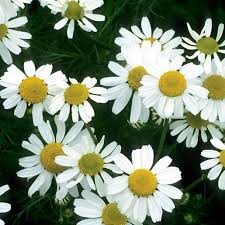
- Benefits: Famous for its calming effects, chamomile helps with stress, anxiety, insomnia, and digestion.
- Growing Tips: Thrives in small pots with light soil. Needs sunlight for at least 4–6 hours a day.
- Quick Remedy: Brew fresh chamomile tea before bed to relax and sleep better.
2. Lavender – The Stress Reliever
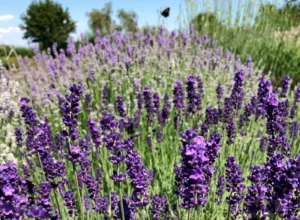
- Benefits: Known for reducing anxiety, promoting sleep, and healing skin irritations.
- Growing Tips: Loves sunny spots and well-drained soil. Works well in terracotta pots.
- Quick Remedy: Keep a dried lavender sachet under your pillow for restful sleep.
3. Peppermint – The Stomach Soother
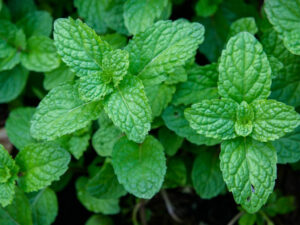
- Benefits: Eases indigestion, nausea, and headaches.
- Growing Tips: Grows quickly in pots. Prefers partial shade and moist soil.
- Quick Remedy: Sip peppermint tea after meals for smoother digestion.
4. Echinacea – The Immunity Booster
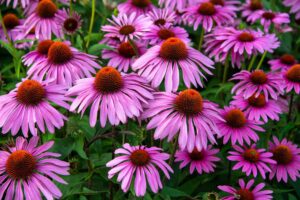
- Benefits: Strengthens your immune system and helps fight colds and flu.
- Growing Tips: Use a medium-sized pot and place in full sun. Water moderately.
- Quick Remedy: Brew echinacea root tea at the first sign of a cold.
5. Calendula – The Skin Healer
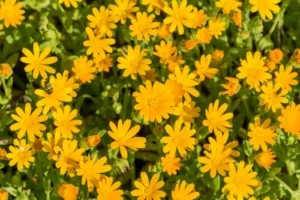
- Benefits: Excellent for wound healing, reducing scars, and soothing skin.
- Growing Tips: Thrives in medium pots with rich soil and partial sun.
- Quick Remedy: Make a calendula salve for cuts, scrapes, or burns.
🌿 6. Aloe Vera – The Skin Soother
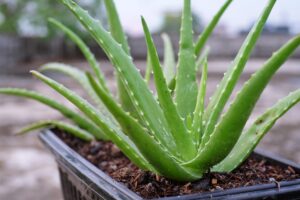
- Benefits: Known for treating burns, rashes, and skin hydration. Also supports digestion when used carefully.
- Growing Tips: Prefers small pots with sandy, well-drained soil. Minimal watering required.
- Quick Remedy: Cut a leaf and apply fresh aloe gel directly to burns.
🌿 7. Feverfew – Nature’s Aspirin
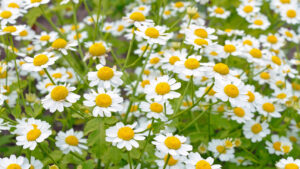
- Benefits: Helps with migraines, fever reduction, and pain relief.
- Growing Tips: Compact herb perfect for small containers. Needs sunlight but tolerates partial shade.
- Quick Remedy: Chew a fresh feverfew leaf at the onset of migraine (in moderation).
🌿 8. Basil – The Anti-Inflammatory Herb
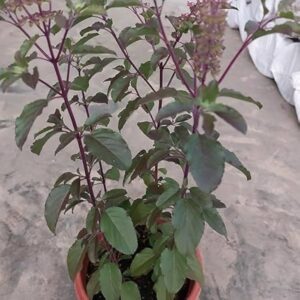
- Benefits: Supports digestion, reduces inflammation, and boosts immunity.
- Growing Tips: Does best in kitchen pots with daily sunlight. Easy for beginners.
- Quick Remedy: Brew basil tea for digestion and cold relief.
🌿 9. Lemon Balm – The Mood Lifter
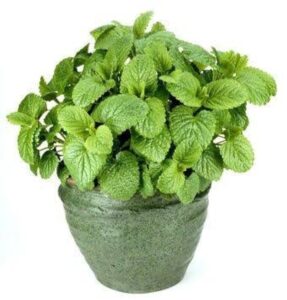
- Benefits: Calms nerves, improves sleep, and helps with cold sores.
- Growing Tips: Thrives in small pots and grows quickly. Needs partial shade and moist soil.
- Quick Remedy: Drink lemon balm tea to reduce stress and lift mood.
🌿 10. Thyme – The Natural Antiseptic
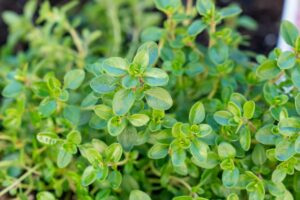
- Benefits: Excellent for coughs, sore throats, and respiratory infections.
- Growing Tips: Requires small pots, plenty of sunlight, and well-drained soil.
- Quick Remedy: Steep thyme tea to soothe a sore throat naturally.
👉 With just these 10 potted herbs, you’ll have a constant supply of natural remedies right at home. Now, let’s explore how to keep them healthy and thriving in containers.
Essential Tips for Growing Medicinal Herbs in Pots
Growing herbs in pots is simple, but a few smart practices will make the difference between a struggling plant and a thriving mini-garden. Here’s what you need to know:
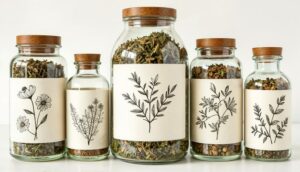
🌱 1. Choose the Right Pot Size & Material
- Small herbs like thyme, chamomile, and feverfew do well in 6–8 inch pots.
- Larger herbs like aloe vera or echinacea need 10–12 inch pots.
- Terracotta or clay pots are best because they allow air circulation and prevent waterlogging.
🌱 2. Use Quality Potting Soil
- Avoid plain garden soil—it can be too heavy for pots.
- Use a light, well-draining potting mix with compost for nutrition.
- Adding a bit of sand or perlite helps improve drainage.
🌱 3. Ensure Proper Drainage
- Always pick pots with drainage holes at the bottom.
- Herbs hate “wet feet”—too much water can cause root rot.
- Place a saucer under each pot to catch excess water.
🌱 4. Place in the Right Spot
- Most medicinal herbs love sunlight (at least 4–6 hours daily).
- A balcony, kitchen windowsill, or patio is perfect.
- If indoors, consider a grow light during winter months.
🌱 5. Water the Smart Way
- Overwatering is the #1 mistake.
- Check soil moisture with your finger—if the top inch feels dry, it’s time to water.
- Herbs like aloe vera need very little water, while mint and lemon balm prefer moist soil.
🌱 6. Harvest Regularly
- The more you harvest leaves, the more your plant grows.
- Don’t strip the plant bare—leave at least one-third of the leaves.
- Best time to harvest: morning, after dew has dried.
👉 With just these steps, you’ll keep your herbs healthy, productive, and ready to use anytime you need them. Next, let’s look at how you can turn these potted herbs into simple, powerful remedies.
Simple Remedies You Can Make from Potted Herbs
One of the most rewarding parts of growing medicinal herbs in pots is being able to turn them into natural remedies whenever you need them. You don’t need to be an herbalist—just a few leaves or flowers can make a big difference for everyday wellness.
Here are some easy remedies you can try right at home:
🍵 1. Herbal Teas (Infusions)
- Chamomile Tea → Calms stress and helps with sleep.
- Peppermint Tea → Soothes digestion and relieves nausea.
- Lemon Balm Tea → Reduces anxiety and lifts mood.
- Thyme Tea → Helps fight coughs and sore throats.
👉 Simply steep fresh or dried leaves/flowers in hot water for 5–10 minutes.
🌿 2. Healing Salves & Balms
- Calendula Salve → Great for cuts, scrapes, and burns.
- Lavender Balm → Soothes skin irritation and calms nerves.
👉 Make by infusing dried flowers in oil, straining, then mixing with melted beeswax.
💧 3. Herbal Tinctures
- Echinacea Tincture → Supports immunity during cold/flu season.
- Feverfew Tincture → Helps with migraines and headaches.
👉 Create by soaking fresh or dried herbs in alcohol (like vodka) for several weeks, then straining.
🌵 4. Aloe Gel (Direct Use)
- Slice an aloe vera leaf and scoop out the gel.
- Use directly on burns, rashes, insect bites, or dry skin.
🌸 5. Herbal Inhalation
- Add lavender or thyme to a bowl of hot water.
- Inhale the steam to help with colds, congestion, or relaxation.
👉 These remedies are safe, natural, and incredibly easy to prepare at home. With just a few pots on your balcony or windowsill, you’ll always have a mini pharmacy at your fingertips.
Next, let’s connect this to your larger garden journey and see how you can expand beyond pots into a full healing garden.
Want More Healing Plants for Your Home Garden?
What we’ve covered so far are some of the easiest herbs to grow in pots, but the world of medicinal plants is much bigger. 🌿 While pots are perfect for balconies and small spaces, imagine expanding into a dedicated garden bed where you can grow even more powerful healing plants side by side.
Think about it—beyond chamomile, peppermint, and lavender, there are plants like yarrow, evening primrose, and marshmallow root that can take your home remedies to the next level. These plants not only heal but also bring beauty, fragrance, and diversity to your living space.
If you’re curious to explore the full list of 10 essential medicinal plants for home gardening and learn how to grow them, I’ve put together a detailed guide just for you.
👉 Check out my main article here: Top 10 Medicinal Plants for Home Gardening
It’s the perfect next step if you’re ready to move beyond pots and build a small but powerful backyard pharmacy.
Final Thoughts: Small Pots, Big Healing Power
Starting a medicinal garden doesn’t have to be overwhelming. Even if all you have is a sunny window, a balcony, or a corner in your kitchen, you can grow powerful healing herbs in pots.
From chamomile to soothe stress, to aloe vera for burns, to peppermint for digestion—these humble plants can make a big difference in your everyday health. The best part? They’re always within arm’s reach.
So, begin small. Pick just two or three herbs you’ll actually use, and let them be the start of your home remedy garden. Over time, you can add more, creating a personal green pharmacy that saves you trips to the store and gives you peace of mind.
🌿 Ready to take the next step?
If you want to skip the guesswork and start with a carefully curated selection of the 10 most essential medicinal plants, I recommend checking out the Medicinal Garden Kit. It’s a simple way to get everything you need to build your own backyard pharmacy—whether in pots or a full garden.
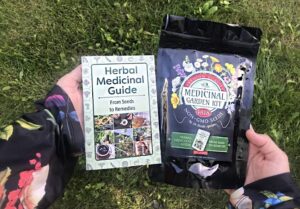
👉 Click here to learn more about the Medicinal Garden Kit
With just a few pots of green, you’re not just growing plants—you’re growing health, peace, and self-reliance right at home. 🌸
🔬 References
-
World Health Organization (WHO). WHO Traditional Medicine Strategy 2014–2023. https://www.who.int/publications/i/item/9789241506090
-
U.S. National Center for Complementary and Integrative Health (NCCIH), NIH. Chamomile: Overview and Uses. https://www.nccih.nih.gov/health/chamomile
-
U.S. National Center for Complementary and Integrative Health (NCCIH), NIH. Lavender: At a Glance. https://www.nccih.nih.gov/health/lavender
-
U.S. National Center for Complementary and Integrative Health (NCCIH), NIH. Peppermint Oil: Overview. https://www.nccih.nih.gov/health/peppermint-oil
-
U.S. National Center for Complementary and Integrative Health (NCCIH), NIH. Echinacea: At a Glance. https://www.nccih.nih.gov/health/echinacea
-
U.S. National Center for Complementary and Integrative Health (NCCIH), NIH. Aloe Vera: Overview. https://www.nccih.nih.gov/health/aloe-vera
-
U.S. National Library of Medicine (PubMed). Calendula officinalis: Potential Uses in Wound Healing. https://pubmed.ncbi.nlm.nih.gov/20363007/
-
Mayo Clinic. Feverfew for Migraine Prevention. https://www.mayoclinic.org/drugs-supplements-feverfew/art-20364629
-
U.S. National Library of Medicine (PubMed). Melissa officinalis (Lemon Balm) for Anxiety and Insomnia. https://pubmed.ncbi.nlm.nih.gov/18602424/
-
Cleveland Clinic. Thyme: Health Benefits and Uses. https://my.clevelandclinic.org/health/articles/22354-thyme